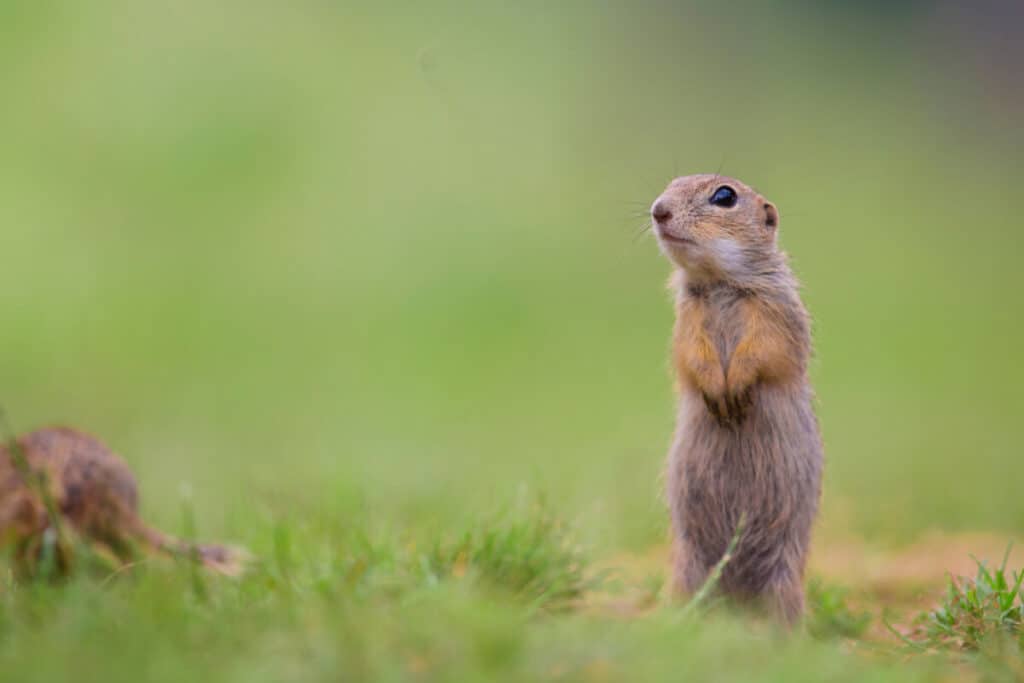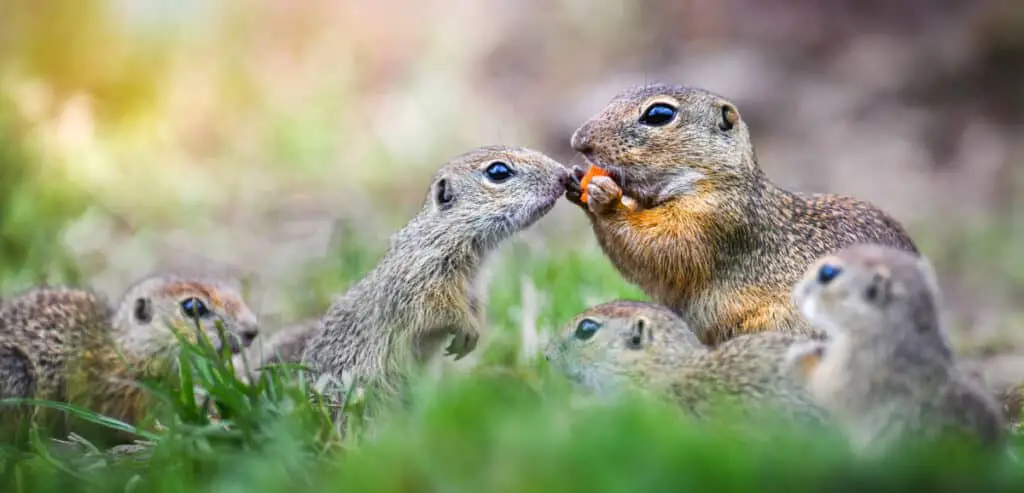Ground squirrels are a type of small mammal that can be found throughout North America, Europe, and Asia. They belong to the family Sciuridae and are closely related to other species such as chipmunks, marmots, and prairie dogs.
Ground squirrels are known for their burrowing behavior and have adapted well to living in diverse habitats ranging from deserts to alpine meadows. There are over 50 species of ground squirrel, each with its unique physical characteristics and behavioral patterns.
Most ground squirrels range in size from 10-30 centimeters in length and weigh between 100-400 grams. Their fur color ranges from grayish-brown to reddish-brown, depending on the species and habitat they inhabit. Ground squirrels feed mainly on plant material such as seeds, nuts, fruits, and leaves but may also consume insects or even small animals if necessary.
In this article, we will explore the different types of ground squirrels found across the world along with their ecological roles and adaptations for survival in various environments.

Diversity Of Ground Squirrel Species
Ground squirrels are a diverse group of rodents belonging to the family Sciuridae. There are over 60 species of ground squirrel distributed throughout North America, Asia, and Europe. These animals vary in size from small chipmunk-like species that weigh less than an ounce, to larger marmot-like species that can weigh up to several pounds.
One common trait among many ground squirrel species is their hibernation habits. Ground squirrels typically enter into a state of torpor during winter months when food sources become scarce. During this time, their metabolic rate slows down significantly and they conserve energy by lowering their heart rate and body temperature.
However, not all ground squirrel species follow the same hibernation pattern as some may remain active year-round or undergo shorter periods of dormancy. Geographical distribution also plays a significant role in shaping these differences in hibernation patterns between different species of ground squirrels.
Physical Characteristics Of Ground Squirrels
As the saying goes, ‘Appearances can be deceiving.’ This is certainly true for ground squirrels, as their physical characteristics may not always reflect the complexity of their behavior.
Burrowing behavior is a key aspect of many ground squirrel species’ lives. These animals often dig extensive underground tunnels and chambers that serve multiple purposes such as providing shelter from predators and extreme weather conditions, as well as storage space for food.
Another noteworthy aspect of ground squirrel behavior is their hibernation patterns. During winter months when resources are scarce, some species undergo torpor or deep sleep to conserve energy until spring arrives. Ground squirrels are able to slow down their metabolism significantly during this time and survive on stored fat reserves. Their ability to enter into this state also helps them avoid predation by sleeping through periods when they are vulnerable due to lack of mobility.
Overall, understanding the behavioral adaptations of ground squirrels alongside their physical characteristics provides insight into these fascinating creatures’ complex lives in the wild.
Behavioral Patterns Of Ground Squirrels
Ground squirrels exhibit a range of behavioral patterns that are crucial to their survival and reproduction. One of the most notable behaviors is burrow construction, which plays an important role in protecting ground squirrels from predators and harsh weather conditions. Burrows provide shelter for individuals and groups, as well as storage areas for food resources.
The process of burrow excavation involves digging with their front legs and pushing out soil with their hind legs. Ground squirrels also use specialized chambers within the burrow system for specific purposes such as nesting, hibernation, and rearing young.
Social hierarchy is another key aspect of ground squirrel behavior where dominant individuals have access to preferred resources including mates, shelter, and food. Dominance hierarchies typically form through aggressive interactions between individuals; however, some evidence suggests that kinship relationships may also play a role in social organization.
For example, female ground squirrels tend to remain near their natal territories while males often disperse in search of new territory or mates leading to sex-specific differences in social structure. Overall, understanding these behavioral patterns can help shed light on how ground squirrels adapt to changing environmental conditions over time.
In summary, the behaviors exhibited by ground squirrels such as burrow construction and social hierarchy are essential components of their life history strategies. These behaviors enable them to survive under harsh environmental conditions and maintain reproductive success over generations. Future research should continue investigating the mechanisms underlying these behaviors including genetic factors influencing social structure and ecological factors driving changes in burrow architecture.
Ecological Roles Of Ground Squirrels
Ground squirrels play an important ecological role in many ecosystems. They are considered a keystone species, meaning that they have a disproportionately large impact on their environment relative to their abundance.
Ground squirrels help maintain the health and diversity of ecosystems by altering the physical characteristics of their habitat through burrowing activities. Their digging creates complex underground tunnel systems that improve soil quality, increase water infiltration rates, and provide shelter for other species.
The impact of ground squirrels on ecosystems extends beyond changes to their physical surroundings. Their interactions with other species can also be significant.
For example, ground squirrels serve as prey for predators such as hawks, weasels, foxes, and snakes. In turn, these predators may limit the population size of certain prey species or prevent them from becoming too abundant.
Additionally, ground squirrel burrows can provide homes for other animals such as insects and reptiles, which further contribute to ecosystem biodiversity.
Adaptations For Survival In Different Environments
Ground squirrels have managed to adapt to a variety of environments, from hot deserts to cold tundras. In fact, there are over 60 different species of ground squirrels found across North America alone. These animals have developed unique survival strategies that allow them to thrive in their respective habitats.
One interesting statistic is that some species of ground squirrels can burrow up to six feet underground! This adaptation allows them to escape predators and extreme weather conditions while also providing a safe place for food storage.
Ground squirrels use various burrowing techniques depending on the type of soil they encounter. Some will dig straight down while others create complex tunnel systems with multiple entrances and exits. Additionally, these animals possess specialized cheek pouches which enable them to transport large amounts of food back to their burrows for later consumption.
Despite facing harsh environmental conditions, ground squirrels display remarkable resilience and determination. Their ability to store food within their burrows showcases an impressive level of foresight and planning. The intricacy of their burrowing systems highlights their intelligence and resourcefulness.
Overall, the adaptations displayed by ground squirrels demonstrate how animals can successfully navigate challenging environments through creative solutions. By utilizing innovative techniques such as storing food or constructing intricate tunnels, these creatures showcase just how adaptable life can be in even the most inhospitable places on Earth.

Threats To Ground Squirrel Populations
Habitat loss is one of the main threats to ground squirrel populations. As human activities continue to expand, natural habitats are being destroyed or modified, leading to reduced availability of food and shelter for these squirrels.
In addition, fragmentation of habitats can lead to isolation of different populations, which in turn reduces genetic diversity and increases vulnerability to disease outbreaks.
Predation pressure is another significant threat faced by ground squirrel populations. These animals serve as prey for a wide range of predators such as foxes, coyotes, hawks, and snakes.
While predation is a natural part of the ecosystem, increased predation due to habitat loss or other factors can have devastating effects on ground squirrel populations. For instance, if predator numbers increase rapidly in an area with a high density of ground squirrels, it could result in local extinction of those squirrels.
In summary, both habitat loss and predation pressure pose serious threats to ground squirrel populations. To ensure their survival and conservation efforts must focus on mitigating these risks through measures such as habitat protection and management strategies that reduce predation rates without harming native predator species.
By addressing these challenges head-on, we can help preserve this important component of our ecosystems for future generations.
Conclusion
Ground squirrels are a diverse group of rodents that inhabit different environments all over the world.
They exhibit various physical and behavioral characteristics, such as their ability to hibernate or communicate with vocalizations.
These traits have allowed ground squirrels to occupy different ecological niches and play important roles in maintaining ecosystem balance.
However, despite their adaptability, ground squirrel populations face threats from habitat loss and fragmentation due to human activities.
This highlights the need for conservation efforts to protect these animals and preserve the delicate web of life on which we all depend.
By recognizing the importance of each species’ contribution to this ecosystem, we can work towards creating a more sustainable future where both humans and wildlife thrive together.

